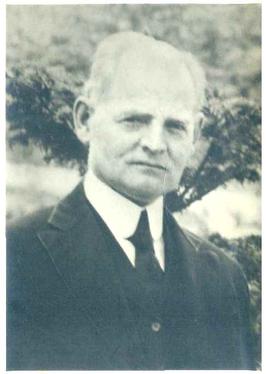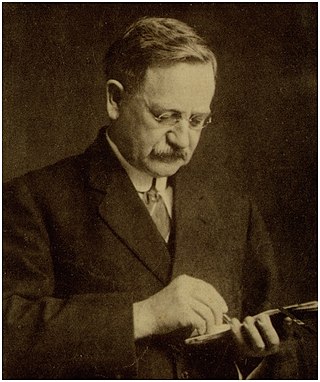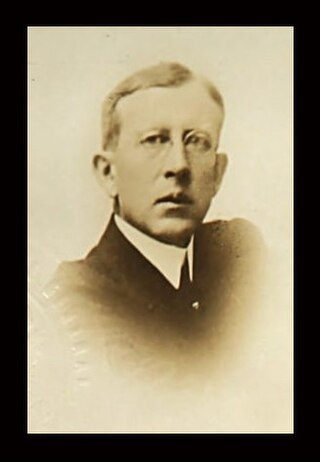
Horace Newton Allen was a missionary, physician, and American ambassador to Korea. Along with Robert Samuel Maclay, Allen was one of the first Western Protestant missionaries in Korea, arriving there on September 15, 1884.

Visceral leishmaniasis (VL), also known as kala-azar or "black fever", is the most severe form of leishmaniasis and, without proper diagnosis and treatment, is associated with high fatality. Leishmaniasis is a disease caused by protozoan parasites of the genus Leishmania.

Sir Patrick Manson was a Scottish physician who made important discoveries in parasitology, and was a founder of the field of tropical medicine. He graduated from University of Aberdeen with degrees in Master of Surgery, Doctor of Medicine and Doctor of Law. His medical career spanned mainland China, Hong Kong, Taiwan and London. He discovered that filariasis in humans is transmitted by mosquitoes. This is the foundation of modern tropical medicine, and he is recognized with an epithet "Father of Tropical Medicine". This also made him the first person to show pathogen transmission by a blood-feeding arthropod. His discovery directly invoked the mosquito-malaria theory, which became the foundation in malariology. He eventually became the first President of the Royal Society of Tropical Medicine and Hygiene. He founded the Hong Kong College of Medicine for Chinese and the London School of Hygiene & Tropical Medicine.

Dr Chandreshwar Prasad Thakur or C. P. Thakur is a former member of Rajya Sabha, a former minister in the Government of India, a physician and a leader of Bharatiya Janata Party (BJP). He was a cabinet minister from 1999 to 2004 in the BJP government.

Medical missions in China by Catholic and Protestant physicians and surgeons of the 19th and early 20th centuries laid many foundations for modern medicine in China. Western medical missionaries established the first modern clinics and hospitals, provided the first training for nurses, and opened the first medical schools in China. Work was also done in opposition to the abuse of opium. Medical treatment and care came to many Chinese who were addicted, and eventually public and official opinion was influenced in favor of bringing an end to the destructive trade. By 1901, China was the most popular destination for medical missionaries. The 150 foreign physicians operated 128 hospitals and 245 dispensaries, treating 1.7 million patients. In 1894, male medical missionaries comprised 14 percent of all missionaries; women doctors were four percent. Modern medical education in China started in the early 20th century at hospitals run by international missionaries.
Mohan Mishra was an Indian physician, known for his studies on Visceral leishmaniasis, and its treatment using Amphotericin B, regarded by many as a pioneering attempt. The Government of India honoured him, in 2014, with the award of Padma Shri, the fourth highest civilian award, for his contributions to the fields of medicine.

John Abner Snell, also known as Soo E. Sang, was a missionary surgeon and hospital administrator in Suzhou (Soochow), China. Snell was a devout Christian, and as early as age 14 he stated: "I aim to devote myself to God's service." After graduating from Vanderbilt Medical College in 1908, Dr. Snell applied for a post at the Methodist Missionary Society. He was appointed to the Methodist Episcopal Church (South) Hospital in Soochow.

Robert Alexander Hardie was a Canadian physician and Methodist evangelist who for 45 years served as a missionary in Korea. He is recognized as the catalyst for the Wŏnsan Revival (1903) and also inspired the Great Pyongyang Revival (1907) in what is now North Korea.
L. Everard Napier was a British tropical physician and professor of tropical medicine, known for his 1946 textbook Principles and Practice of Tropical Medicine and his 1923 book, coauthored by Ernest Muir, Kala Azar: A Handbook for Students and Practitioners.

Oliver R. Avison was a Canadian doctor, physician, humanitarian, missionary and professor, who spent over four decades spreading Western medical knowledge in Korea during the Kaehwagi or Enlightenment Period. Avison was recognized for founding and opening the Severance Hospital and the Severance Medical College in Seoul in 1904, two interlinked institutions that sought to treat the sick and expose the Korean natives to the practical teachings of Western medicinal sciences. Through fundraising efforts across North America prior to the opening, Avison received a series of donations from American philanthropist Louis H. Severance, the namesake for the teaching hospital.

Colonel Frederick Percival MackieCSI OBE KHS FRCP FRCS was an English physician who was in the Indian Medical Service between 1901 and 1931 working on the incidence, transmission, and pathology of insect-borne tropical diseases. He discovered the vectors for relapsing fever and kala-azar. He had important administrative responsibilities in Iraq during the First World War and emerged as a leading figure in Indian medical science, public health, and tropical hygiene between the wars as director of the Haffkine Institute in Bombay (Mumbai).
Gordon King, Chinese name Wang Guodong, was an English gynaecologist who taught in Hong Kong, China, Australia, and Kenya.

Dr. Jean Isabelle Dow was a Canadian medical missionary, who was regarded as a pioneer in women's health care for her work as a member of, and one of the only women in, the Canadian Presbyterian Church Mission in the Honan province of China. She played an important role in treating visceral leishmaniasis disease and in creating female specific hospitals where women could be treated as first-class citizens.
Kala azar in India refers to the special circumstances of the disease kala azar as it exists in India. Kala azar is a major health problem in India with an estimated 146,700 new cases per year as of 2012. In the disease a parasite causes sickness after migrating to internal organs such as the liver, spleen and bone marrow. If left untreated the disease almost always results in the death. Signs and symptoms include fever, weight loss, fatigue, anemia, and substantial swelling of the liver and spleen.
William Twining (1790–1835) was a British military surgeon who practiced in the Indian Subcontinent.
Sister Dr Mary Aquinas Monaghan MB, FRCP, OBE was an Irish Missionary Sister of St Columban nun and physician, and was among the first four nuns to qualify as physicians in Ireland. She was considered an authority on the treatment and management of tuberculosis.
Florence Jessie Murray was a Canadian medical doctor, missionary, and professor who worked in Korea for over forty years, notable for her pioneering contributions as a woman in the male-dominated field of medicine, dedication to service during World War II and the Korean War, and innovation in improving medical care in Korea, specifically in treating tuberculosis and leprosy. Her leadership of the Severance hospital contributed to the development of Yonsei University. Additionally, the hospital she founded and led, the Wonju United Christian Hospital became the Yonsei University Mirae Campus. Recognized with several honorary degrees, she permanently returned to Canada in 1969, where she continued to share her passion for service through domestic projects and her memoirs.

Samuel Cochran was an American medical missionary and philanthropist who worked for over twenty years in Eastern China. One of the "first half-dozen physicians in China," Cochran was the Station Chairman for the Hwai-Yuen Mission. Under his leadership, two hospitals were erected in Hwai-Yuen, with one specifically dedicated to local women. Cochran served as president of the Medical Association of China for two terms. Later, Cochran transitioned to academia, working for Shantung Christian University. and inspiring the merger between the university's medical program with Peking Women's Medical School to develop a teaching hospital. Cochran's long-term research, started at the mission and continued at the university, focused on treating Kala-Azar, a parasitic disease endemic to China. Cochran would retire to the United States, continuing medical and academic work there until 1951.
Ernest Muir FRCS, CIE, CMG was a Scottish medical missionary and educator in British-controlled India and Nigeria most noted for his work with Hansen's disease (leprosy).













